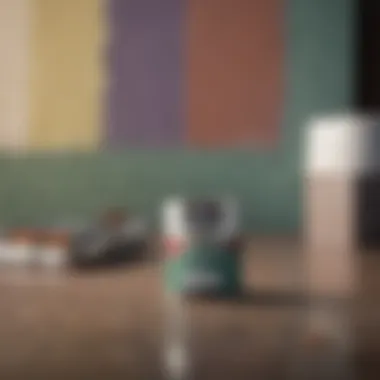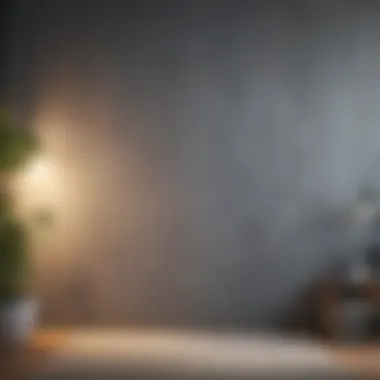Mastering Paint Chip Repair Techniques for Walls


Intro
Paint chips can be an eyesore, ruining the aesthetics of your carefully curated interior space. Understanding how to effectively repair these blemishes is crucial for homeowners and design enthusiasts alike. This guide aims to provide a comprehensive overview of the techniques and materials necessary for paint chip repair, as well as insights into how to prevent future damage.
In every home, wear and tear is inevitable. The walls experience daily impacts from furniture, children, and pets, often leading to paint chips or scratches. It is essential first to recognize the causes of paint damage; this knowledge not only assists in repair but also aids in selecting paint and finishes that are more durable. Repairing paint chips not only enhances the appearance of walls but also protects the integrity of the paint beneath.
The goal is to empower readers with the necessary skills to tackle these repairs confidently. By knowing the right steps, materials, and techniques, homeowners can maintain their walls more effectively and prolong the life of their interior spaces.
Design Inspiration
Trending Styles and Themes
The choice of paint, as well as the repair methods, should often reflect the overall design theme of the home. Adaptation to current trending styles like minimalism or rustic chic can influence the approach to paint maintenance. For example, in a minimalist environment, choosing neutral colors and seamless repairs can create a more unified look. Alternatively, a vibrant, eclectic theme may embrace color variations, adding character to imperfections.
Color Palettes and Combinations
When selecting colors for walls, it is crucial to consider how they will work with the existing furnishings and decor. A harmonious color palette can transform limitations into design features. If you find yourself needing to blend repaired areas into the existing color, color matching becomes essential.
For effective blending, consider these common strategies:
- Use color fans or samples: Compare shades to identify the closest match.
- Test small patches: Before full repair, apply sample patches to see how the new paint interacts with existing colors.
- Utilize tools: Apps or online resources can aid in color matching for a more precise blend.
"Proper color matching is key to seamless wall repairs. A mismatched repair can draw more attention than the original damage."
As you embark on the journey of wall repair, remember that each step contributes to a fuller aesthetic experience within your space. The methods emphasized in this comprehensive guide will ensure that your walls remain not just functional but visually appealing.
Understanding Paint Chips
Understanding paint chips is pivotal for maintaining the aesthetic appeal and integrity of walls in any interior space. This section aims to outline the significance of comprehending paint chips and the context in which they occur. Not only do they compromise the visual quality of a room, but they can also indicate underlying issues related to wall conditions and environmental factors. By knowing what leads to paint chips, homeowners and design professionals can address problems adeptly, preventing further damage and enhancing the longevity of their paintwork.
Definition and Types
Paint chips are small sections of paint that have come off the surface of a wall due to various reasons. They can vary in size, from tiny flecks to larger segments where the paint has peeled away. The types of paint chips can be categorized mainly into two groups: superficial chips, which are minor and affect only the top layer of paint, and deep chips that may expose the underlying material, such as drywall or plaster. Recognizing these distinctions is essential for selecting suitable repair methods.
Common Causes of Paint Chips
Several factors contribute to the formation of paint chips. Understanding these causes can aid in formulating effective prevention and repair strategies. Below are noteworthy contributors:
Furniture movement
Furniture movement is a significant cause of paint chips. When furniture is pushed or pulled across walls, it can lead to abrasion, causing the paint to wear away. This is particularly common in high-traffic areas or where furniture is frequently rearranged. Homeowners should consider protective measures, such as felt pads or corner guards. However, a unique disadvantage is that not all protective measures completely prevent damage, especially if furniture is heavy or awkwardly shaped.
Pet activity
Pet activity also plays a crucial role in paint chip formation. Animals, particularly dogs and cats, may scratch or bump against walls, resulting in chips. The playful nature of pets may unintentionally lead to wall damage, especially in households with young or active animals. A noteworthy advantage of understanding this cause is that pet owners can implement preventative strategies, such as covering walls with pet-friendly materials or using paint with enhanced durability. However, there is an obvious trade-off between aesthetics and the practicality of these solutions.
Impact from objects
Impact from objects represents another leading cause of paint chips. This can happen in many scenarios, such as falling objects or frequent bag placements against walls. The key characteristic here is the sudden force exerted on the wall surface, which can rapidly compromise the integrity of the paint layer. The solution often involves repositioning frequently used items away from walls or using hooks. Yet, a disadvantage of this tactic is that it may not always be feasible in compact living spaces.
Humidity and moisture


Humidity and moisture can have a profound impact on paint integrity. High humidity levels cause paint to swell. Over time, this can result in peeling or chipping. Recognizing humidity as a contributing factor is beneficial for homeowners, enabling them to invest in dehumidifiers or moisture-resistant paints to mitigate damage. However, controlling humidity effectively can require significant ongoing attention and resources.
Tools and Materials for Repair
In the realm of paint chip repair, having the right tools and materials is essential. Each item contributes uniquely to the success of the repair process. Understanding these tools can save time and ensure a high-quality finish. Selecting proper materials can not only enhance the appearance of the wall but also extend the life of the repair. Here, we detail the essential tools and the importance of choosing the right paint for effective repairs.
Essential Tools
Putty knife
The putty knife is a fundamental tool in any paint chip repair project. It is primarily used for applying filler compounds into the damaged area. A key characteristic of the putty knife is its flexible blade, which allows for a smooth application of material. This flexibility helps in achieving an even surface, crucial for a seamless finish. The size of the putty knife can vary, but a 2- to 3-inch wide blade is often regarded as a beneficial choice for general repairs. Its main advantage is its versatility; however, it can be less effective if it is not held at the correct angle while applying the filler.
Sandpaper
Sandpaper plays a critical role in preparing and finishing a repair area. It is used to smooth out the filler after it has dried. The key characteristic of sandpaper is its grit, which ranges from coarse to fine. For repairs, a medium grit (around 120) is often beneficial for leveling the surface. After the initial sanding, a fine grit (around 220) is recommended for a smooth finish. One unique feature of sandpaper is its ability to conform to various surfaces, making it easier to achieve a smooth appearance. It is important to note that over-sanding can damage surrounding paint, so one must use sandpaper judiciously.
Brushes and rollers
Brushes and rollers are essential for applying paint in the repair area. Brushes are useful for detailed work and edges, while rollers are effective for larger surfaces. A key characteristic of a good quality brush is its bristle construction, which helps deliver even paint distribution. For a roller, the nap thickness depends on the texture of the wall; a short nap is suitable for smooth surfaces, while a medium nap works well on textured walls. Their advantage lies in their ability to cover areas quickly, reducing the time spent on repairs. However, they can lead to uneven application if not used properly.
Paint tray
The paint tray is a simple yet vital tool for any painting project. Its primary function is to hold the paint accessible for brushes and rollers. A well-designed tray has a ribbed bottom that allows excess paint to drip back into the tray, preventing waste. This characteristic makes it a practical choice for ensuring a clean workspace. The unique feature of a paint tray includes its capacity to hold various amounts of paint. While it is a basic tool, neglecting to use a paint tray can lead to messy applications and wasted materials, as well as frustrations during the painting process.
Choosing the Right Paint
Selecting the right paint is paramount for achieving a successful repair. Different types of paint serve various needs, and understanding these can greatly influence the outcome of your wall's appearance.
Finish types
Finish types refer to the sheen of the paint, ranging from flat to high gloss. Each finish has specific benefits; for instance, flat paint can help hide imperfections, making it a popular choice for walls with existing blemishes. On the other hand, satin or semi-gloss finishes tend to be more durable and easier to clean. The right choice of finish contributes significantly to aesthetics and longevity, therefore, selecting the appropriate one for the room's use is key.
Color matching
Color matching is critical when repairing paint chips. This process ensures that the newly applied paint blends seamlessly with the existing wall color. The significant aspect of color matching involves using tools like spectrophotometers or color swatches to find the most accurate match. This step is beneficial as it can enhance overall appearance and avoid noticeable repair spots. However, even with blinds methods, it may be difficult to achieve a perfect match due to the aging of existing paint.
Paint brands and qualities
The selection of paint brands and qualities can vary greatly and is crucial for the durability of the repair. Established brands like Sherwin-Williams and Benjamin Moore are often preferred for their proven performance. High-quality paints typically offer better coverage and longevity, reducing the frequency of future repairs. A significant advantage of investing in quality paint is its resistance to wear and cleaning, while lower quality options may fade or chip more quickly under similar conditions.
Surface Preparation
Surface preparation is a crucial phase in the paint chip repair process. Engaging in thorough preparation increases the likelihood of a successful repair. It helps to ensure that the paint adheres well to the repaired area, preventing future chips or peeling.
The initial step involves assessing the damage. Determining the scope of the paint chips allows you to comprehend the nature of the repairs needed. A simple visual inspection should suffice, but it is essential to consider the surface beneath the chip. If the wall underneath has also been compromised, different repair strategies may be required. A well-prepared surface can significantly enhance the final appearance of the repair.
Cleaning the area next is imperative. Any dust, grease, or debris may disrupt adhesion. Use a damp cloth to wipe the area surrounding the paint chip. In cases of extensive dirt, employing a mild detergent can be beneficial. Ensure the surface is completely dry before proceeding. If you skip this part, you may notice the paint failing to bond properly.
Finally, sanding the chip is necessary. This process smooths out any uneven edges around the damage. Use fine-grit sandpaper for this task, as it provides a more polished finish. Sanding helps the filler or paint to adhere better. Lightly sand the area until it feels smooth, but take care not to go too deep into the underlying wall material.
"Underestimating surface preparation can lead to a poor repair job, wasting both time and resources."
To summarize, effective surface preparation involves proper assessment, thorough cleaning, and careful sanding. Neglecting these steps may result in unsatisfactory outcomes. When done correctly, surface preparation sets a strong foundation for the following repair techniques, laying the groundwork for a seamless repair that can withstand the test of time.


Repair Techniques
Repair techniques play a crucial role in addressing paint chips effectively and restoring the aesthetic appeal of walls. Understanding these methods allows homeowners to make informed decisions when it comes to fixing minor damages. This section will dissect the primary repair techniques, emphasizing their advantages and practical applications. Knowing the right technique can enhance the durability and appearance of the repair, ensuring a cohesive look within the interior space.
Filling in the Chip
Using filler compounds
Using filler compounds is often the first step in repairing a paint chip. Filler compounds are designed to fill voids in the wall surface, allowing for a level and smooth finish. A key characteristic of these compounds is their ability to adhere well to various surface types. They are a popular choice due to their ease of application and effective results.
A unique feature of filler compounds is their formulation, which is typically lightweight and easy to sand. This advantage allows for seamless integration into the wall’s surface. However, they may not be suitable for deep chips or cracks without multiple applications. Thus, knowing the extent of the damage is important for optimal use.
Applying primer
Applying primer after filling in chips is essential for adhesion and color uniformity. The primer creates a uniform base that helps the new paint to bond better, enhancing the longevity of the repair. This step is often seen as beneficial because it bridges the gap between the touch-up area and the existing wall paint.
The unique feature of primer is its coverage capability. It can effectively seal the filler compound, preventing it from soaking up too much paint and leading to an uneven appearance. However, choosing the wrong type of primer can affect the final result. Hence, it is vital to select an appropriate primer based on the wall’s finish and the type of paint used.
Painting Over the Repair
Applying the first coat
Applying the first coat of paint is a significant moment in the repair process. This step not only covers the primer but also sets the tone for the final look of the repair. It is beneficial because it allows the homeowner to visualize how well the repair matches the existing paint.
The unique feature of the first coat is its ability to reveal any imperfections that may need further smoothing. This characteristic can be both advantageous and disadvantageous. While it helps identify areas that may require additional work, it can also be disheartening if the initial repair doesn’t meet expectations. Therefore, patience is important during this stage.
Blending techniques
Blending techniques are employed to seamlessly incorporate the repaired area into the rest of the wall. This aspect is key to achieving a flawless appearance. Effective blending techniques include feathering the edges, which helps to merge the new paint with the old.
A strong characteristic of blending techniques is the use of specialized brushes or rollers that can create a subtle transition between colors. This technique is popular because it minimizes the risk of visible lines or patches. However, it requires practice and a steady hand to master. Thus, beginners may need to try several times to achieve the desired result.
Final Touches
Applying a topcoat
Applying a topcoat is often overlooked but is very important in the repair process. The topcoat not only protects the repair but also enhances the overall finish of the wall. This step is beneficial due to its ability to add durability against wear and tear, especially in high-traffic areas.
The unique feature of a topcoat is its variety, with options ranging from matte to glossy finishes. This variety allows homeowners to choose a finish that aligns with their overall design. However, over-applying can lead to an uneven surface, so careful consideration of the application process is crucial.
Buffing for smoothness
Buffing for smoothness is the last step in ensuring the repair is indistinguishable from the surrounding area. This technique involves gentle polishing to eliminate any rough spots left after painting. The importance of this step cannot be overstated as it can really enhance the feel of the surface.
The key characteristic of buffing is its impact on texture. It can make a painted surface feel as smooth as the surrounding areas. While buffing is beneficial, it requires appropriate tools and a gentle approach. Too much pressure can damage the newly applied paint or filler, leading to further repairs. Thus, a cautious technique is essential to achieve the best results.
Color Matching Techniques
Color matching is a critical aspect of paint chip repair that can greatly affect the overall aesthetic quality of a wall. The aim is to ensure that the repaired area seamlessly blends into the existing paintwork, maintaining a uniform appearance. This task is more than just applying paint; it involves understanding the nuances of color precision and technique. The ability to match paint correctly is essential for various reasons.
First, it enhances the visual appeal of a space. Homeowners and designers strive to create harmonious environments, and mismatched colors can disrupt this harmony. Additionally, proper color matching can save time and resources by avoiding costly mistakes that arise from repeated attempts to fix a poorly matched repair.


Second, as walls age or when they are exposed to elements like sunlight or humidity, the colors can fade or change subtly. Thus, knowing how to match existing colors effectively becomes vital for long-term maintenance.
Lastly, the psychological effect of color can influence how people perceive space. Thus, successful color matching allows for aesthetic congruence, which can positively enhance one's experience in their environment.
Using Color Matching Tools
Color matching tools have become more advanced, providing users with options that produce precise results. Tools like color spectrophotometers and mobile apps can help capture and analyze color accurately.
- Color Spectrophotometer: This device reads and analyzes the color's spectrum, offering an exact match to your wall paint. It measures the reflected light and generates a color sample that can be compared to the paint available at stores.
- Paint Color Apps: Many smartphone applications allow users to take photos of their walls and analyze the color. Some may offer a selection of matching paint brands locally available, simplifying the selection process.
- Fan Decks: Physical sample books, often called fan decks, provide a range of color swatches that can assist in identifying a close match. Moving these samples around the area can help visualize which colors look best in various lighting conditions.
By utilizing these tools, matching colors becomes a more manageable task, allowing for precision that enhances repairs.
How to Match Existing Paint
When attempting to match existing paint, there are several considerations to keep in mind:
- Observe under different lighting: Colors can look different in natural light versus artificial light. It's advisable to evaluate the color at different times of the day.
- Take a sample: If possible, take a small chip of the existing paint to the store. This can help the staff provide better suggestions on the appropriate match.
- Get informed about paint finishes: Different finishes such as matte, eggshell, or glossy may affect how colors appear. Ensure that the selected paint is the same finish as the existing wall.
- Use layering techniques: After applying a base coat, allow it to dry and then assess whether a second coat of a slightly different shade is needed to achieve a perfect blend.
Preventative Measures
Preventative measures play a crucial role in minimizing paint chip damage. By implementing simple strategies, homeowners can significantly reduce the frequency and severity of paint chips on their walls. This proactive approach not only saves time and money but also preserves the aesthetic quality of interior spaces over a longer period. Understanding irritants that may lead to paint damage can help in formulating an effective prevention plan.
Regular Maintenance
Regular maintenance of walls is vital in ensuring that paint remains intact. This includes conducting frequent inspections for scratches, stains, or any signs of wear. Homeowners should pay special attention to high-traffic areas, as these zones tend to experience the most damage. Establishing a routine for cleaning walls can help remove dirt and grime that could potentially lead to peeling or chipping.
Wiping down walls with a mild soap solution can prevent buildup that may affect the integrity of the paint. Additionally, if any furniture or decor causes friction, consider rearranging the layout to reduce contact with walls. Regular touch-ups on minor imperfections will also strengthen the overall finish and lessen the need for extensive repairs later.
Protective Coatings
Applying protective coatings can extend the life of painted surfaces. These coatings act as a barrier, shielding paint from everyday wear and tear. Various types of sealants are available, which can deliver different levels of protection, depending on the aesthetic desired and the environment they are placed in.
Consider using a clear varnish or polyurethane finish on painted walls. These coatings are effective in areas prone to abrasion, such as hallways or children’s playrooms. Moreover, using products designed specifically for high-traffic or moisture-laden environments can offer enhanced durability.
Here are the benefits of protective coatings:
- Enhanced Durability: Keeps paint looking fresh and intact for longer.
- Easier Cleaning: Smooth surfaces are easier to clean, reducing the risk of damage.
- Moisture Resistance: Some coatings provide protection against mold and mildew.
Professional Insights
Understanding when and how to engage a professional for paint chip repair is crucial for achieving optimal results. While many homeowners may feel confident in attempting repairs themselves, there are situations where professional intervention can save time and ensure a higher quality finish. Professionals possess not only the experience but also the specialized skills that often lead to a more durable and aesthetically pleasing result.
When to Hire a Professional
Evaluating whether to hire a professional involves several factors. Here are some considerations that may inform your decision:
- Extent of Damage: If the damage is extensive or if multiple areas require attention, a professional may provide a more efficient solution.
- Skill Level: For those unsure about their own skills in paint repair, consulting with a professional can eliminate the risk of further damaging the wall.
- Time Constraints: Professionals often have the tools and experience to complete repairs quickly. For homeowners with busy schedules, hiring someone may be more practical.
In certain cases, such as older homes with intricate designs or specialized finishes, the need for a professional's expertise becomes even more pronounced. These situations often present unique challenges that require a nuanced approach and a deep understanding of materials and techniques.
Cost Considerations
When weighing the costs of professional services against DIY repairs, several items should be taken into account:
- Labor Costs: Professional painters typically charge by the hour or by the project. Rates can vary based on location and experience.
- Material Quality: Professionals may have access to higher-quality materials that can increase the longevity of the repair.
- Long-term Savings: Although upfront costs may be higher, professional repairs can reduce the need for future touch-ups, potentially saving money in the long run.
- Your Time: Consider the value of your own time. If a project takes too long, it may yield unnecessary stress or interfere with other responsibilities.
"In many cases, the expertise and efficiency of a professional can outweigh the initial financial investment, leading to superior outcomes."
Ultimately, the decision to hire a professional hinges on a balancing act between personal capability and project demands. Being informed about available options ensures you make a choice that aligns with your needs and expectations.



